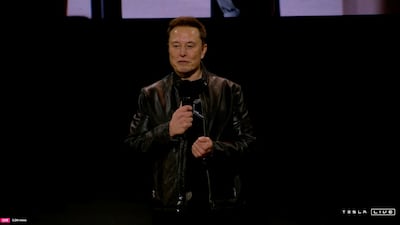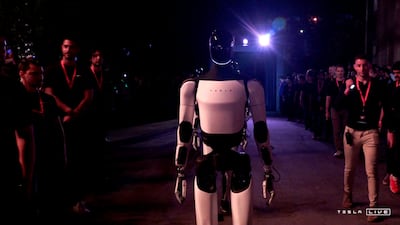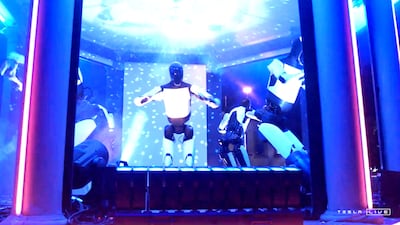Elon Musk's newest toys have been unveiled – and the world's wealthiest person once again played the role of ultimate hype man.
Tesla's Cybercab was finally introduced at an invitation-only glitzy party in Los Angeles on Thursday, giving a peek into a future the company's chief executive has been dreaming of.
Mr Musk said in his presentation that there is “a lot of pain that we take for granted” in today's transportation, which he said “costs too much”, is not safe and is not sustainable.
“You see a lot of sci-fi movies where the future is dark and dismal. It's not a future you want to be in,” he said, drawing cheers from a pro-electric vehicle crowd.
Mr Musk also treated the crowd to the Robovan, a bigger self-driving EV designed to transport up to 20 people, and the Tesla Bots, which are meant to aid in daily chores. He spent the evening dancing, serving drinks and playing rock-paper-scissors with guests.
Here's what you need to know about the new Cybercab. Spoiler alert: no windows failed an integrity test, unlike the Cybertruck.
What took the Cybercab so long?
It was nearly a decade ago in 2015 that Mr Musk first told Tesla shareholders that the company's cars would achieve full autonomy within three years. In 2016, he said that by the end of 2017, a Tesla car would be able to drive across the US without human intervention. In 2019, he said Tesla would have one million robotaxis on roads in 2020.
None of those happened.
Even Thursday's event was delayed: Tesla was originally supposed to hold the big unveiling on August 8, but it was pushed back by two months to let the teams do more work on the EVs.
There were several reasons for the delay and failed promises, most notably the challenge of developing the technology, as well as regulatory scrutiny – especially after accidents involving driverless cars, and what has been perceived as grandiose ambitions in such a short period.
What are the Cybercab's features?
The silver-coloured Cybercab has a familiar Tesla shape. Low and sleek with butterfly doors, it is definitely eye candy.
But its most distinctive feature is the lack of steering wheel and pedals. That should be enough to tell you it does not need a driver. It only has space for two passengers, but with a rear compartment that is bigger than those in standard sedans.
Tesla did not provide the exact dimensions of the Cybercab, but images it released after the event show an apparently spacious interior. A big tablet-like screen sits at the centre of the dashboard.
Elon Musk unveils Tesla's Cybercab – in pictures
When will the Cybercab be available and how much will it cost?
Mr Musk said Tesla would start manufacturing the Cybercab by 2026 but gave no definitive time on when it would be ready for rollout. For perspective, it took four years from its announcement for the Cybertruck to be released and Mr Musk said in 2020 that Tesla was “very close” to achieving full autonomy.
The company aims to keep the cost of the Cybercab below $30,000. Tesla's most affordable car, the Model 3, starts at $29,990 for its long-range rear-wheel drive option, according to the company's website.
How do you charge the Cybercab?
Unlike standard EVs that use plugs to charge them, the Cybercab will use inductive charging, meaning it can just roll up to a charging station or some sort of charging plate.
That suggests it would require bigger infrastructure, unlike today's public and domestic charging stations. It is unclear how Tesla would develop this, especially for an entire fleet of Cybercabs.
Safety first
There has been a lot of debate on when fully autonomous vehicles will become roadworthy. A number of reports have shown that it may take quite a while, with a 2023 study from GlobalData suggesting it would take 20 years to achieve this level of innovation.
Tesla was involved in a fatal incident in 2021, when one of its cars on its Autopilot system crashed and burst into flames in Houston, killing two people. Waymo, the self-driving arm of Google parent Alphabet, has also been involved in crashes.
Tesla has technology it calls Full Self-Driving, an $8,000 option on its EVs. However, the company requires drivers behind the wheel to be ready to take over, even when the feature is activated. The Cybercab, therefore, is Tesla's first real attempt at full autonomy.
Being in a self-driving car would, in theory, allow its “driver” or passengers to do other things, like eat, use a laptop or smartphone, or even sleep. However, there is still the huge risk of the car's systems failing or an out-of-control situation on the road, which drives up the need for an absolutely reliable system.
Let's see if Mr Musk can accelerate the pace – and maybe finally deliver on a promise after years of failed ones.
More on animal trafficking
Champions parade (UAE timings)
7pm Gates open
8pm Deansgate stage showing starts
9pm Parade starts at Manchester Cathedral
9.45pm Parade ends at Peter Street
10pm City players on stage
11pm event ends
The%20US%20Congress%20explained
%3Cp%3E-%20Congress%20is%20one%20of%20three%20branches%20of%20the%20US%20government%2C%20and%20the%20one%20that%20creates%20the%20nation's%20federal%20laws%3C%2Fp%3E%0A%3Cp%3E-%20Congress%20is%20divided%20into%20two%20chambers%3A%20The%20House%20of%20Representatives%20and%20the%20Senate%3C%2Fp%3E%0A%3Cp%3E-%C2%A0The%20House%20is%20made%20up%20of%20435%20members%20based%20on%20a%20state's%20population.%20House%20members%20are%20up%20for%20election%20every%20two%20years%3C%2Fp%3E%0A%3Cp%3E-%20A%20bill%20must%20be%20approved%20by%20both%20the%20House%20and%20Senate%20before%20it%20goes%20to%20the%20president's%20desk%20for%20signature%3C%2Fp%3E%0A%3Cp%3E-%20A%20political%20party%20needs%20218%20seats%20to%20be%20in%20control%20of%20the%20House%20of%20Representatives%3C%2Fp%3E%0A%3Cp%3E-%20The%20Senate%20is%20comprised%20of%20100%20members%2C%20with%20each%20state%20receiving%20two%20senators.%20Senate%20members%20serve%20six-year%20terms%3C%2Fp%3E%0A%3Cp%3E-%20A%20political%20party%20needs%2051%20seats%20to%20control%20the%20Senate.%20In%20the%20case%20of%20a%2050-50%20tie%2C%20the%20party%20of%20the%20president%20controls%20the%20Senate%3C%2Fp%3E%0A
In numbers: China in Dubai
The number of Chinese people living in Dubai: An estimated 200,000
Number of Chinese people in International City: Almost 50,000
Daily visitors to Dragon Mart in 2018/19: 120,000
Daily visitors to Dragon Mart in 2010: 20,000
Percentage increase in visitors in eight years: 500 per cent
The%20specs
%3Cp%3E%3Cstrong%3EPowertrain%3A%20%3C%2Fstrong%3ESingle%20electric%20motor%0D%3Cbr%3E%3Cstrong%3EPower%3A%20%3C%2Fstrong%3E201hp%0D%3Cbr%3E%3Cstrong%3ETorque%3A%20%3C%2Fstrong%3E310Nm%0D%3Cbr%3E%3Cstrong%3ETransmission%3A%20%3C%2Fstrong%3ESingle-speed%20auto%0D%3Cbr%3E%3Cstrong%3EBattery%3A%20%3C%2Fstrong%3E53kWh%20lithium-ion%20battery%20pack%20(GS%20base%20model)%3B%2070kWh%20battery%20pack%20(GF)%0D%3Cbr%3E%3Cstrong%3ETouring%20range%3A%20%3C%2Fstrong%3E350km%20(GS)%3B%20480km%20(GF)%0D%3Cbr%3E%3Cstrong%3EPrice%3A%20%3C%2Fstrong%3EFrom%20Dh129%2C900%20(GS)%3B%20Dh149%2C000%20(GF)%0D%3Cbr%3E%3Cstrong%3EOn%20sale%3A%3C%2Fstrong%3E%20Now%3C%2Fp%3E%0A
THREE
%3Cp%3EDirector%3A%20Nayla%20Al%20Khaja%3C%2Fp%3E%0A%3Cp%3EStarring%3A%20Jefferson%20Hall%2C%20Faten%20Ahmed%2C%20Noura%20Alabed%2C%20Saud%20Alzarooni%3C%2Fp%3E%0A%3Cp%3ERating%3A%203.5%2F5%3C%2Fp%3E%0A
TICKETS
For tickets for the two-day Maharlika Pilipinas Basketball League (MPBL) event, entitled Dubai Invasion 2019, on September 27 and 28 go to www.meraticket.com.
UAE currency: the story behind the money in your pockets
Mercer, the investment consulting arm of US services company Marsh & McLennan, expects its wealth division to at least double its assets under management (AUM) in the Middle East as wealth in the region continues to grow despite economic headwinds, a company official said.
Mercer Wealth, which globally has $160 billion in AUM, plans to boost its AUM in the region to $2-$3bn in the next 2-3 years from the present $1bn, said Yasir AbuShaban, a Dubai-based principal with Mercer Wealth.
“Within the next two to three years, we are looking at reaching $2 to $3 billion as a conservative estimate and we do see an opportunity to do so,” said Mr AbuShaban.
Mercer does not directly make investments, but allocates clients’ money they have discretion to, to professional asset managers. They also provide advice to clients.
“We have buying power. We can negotiate on their (client’s) behalf with asset managers to provide them lower fees than they otherwise would have to get on their own,” he added.
Mercer Wealth’s clients include sovereign wealth funds, family offices, and insurance companies among others.
From its office in Dubai, Mercer also looks after Africa, India and Turkey, where they also see opportunity for growth.
Wealth creation in Middle East and Africa (MEA) grew 8.5 per cent to $8.1 trillion last year from $7.5tn in 2015, higher than last year’s global average of 6 per cent and the second-highest growth in a region after Asia-Pacific which grew 9.9 per cent, according to consultancy Boston Consulting Group (BCG). In the region, where wealth grew just 1.9 per cent in 2015 compared with 2014, a pickup in oil prices has helped in wealth generation.
BCG is forecasting MEA wealth will rise to $12tn by 2021, growing at an annual average of 8 per cent.
Drivers of wealth generation in the region will be split evenly between new wealth creation and growth of performance of existing assets, according to BCG.
Another general trend in the region is clients’ looking for a comprehensive approach to investing, according to Mr AbuShaban.
“Institutional investors or some of the families are seeing a slowdown in the available capital they have to invest and in that sense they are looking at optimizing the way they manage their portfolios and making sure they are not investing haphazardly and different parts of their investment are working together,” said Mr AbuShaban.
Some clients also have a higher appetite for risk, given the low interest-rate environment that does not provide enough yield for some institutional investors. These clients are keen to invest in illiquid assets, such as private equity and infrastructure.
“What we have seen is a desire for higher returns in what has been a low-return environment specifically in various fixed income or bonds,” he said.
“In this environment, we have seen a de facto increase in the risk that clients are taking in things like illiquid investments, private equity investments, infrastructure and private debt, those kind of investments were higher illiquidity results in incrementally higher returns.”
The Abu Dhabi Investment Authority, one of the largest sovereign wealth funds, said in its 2016 report that has gradually increased its exposure in direct private equity and private credit transactions, mainly in Asian markets and especially in China and India. The authority’s private equity department focused on structured equities owing to “their defensive characteristics.”
The%20specs
%3Cp%3E%3Cstrong%3EEngine%3A%3C%2Fstrong%3E%201.8-litre%204-cyl%20turbo%0D%3Cbr%3E%3Cstrong%3EPower%3A%20%3C%2Fstrong%3E190hp%20at%205%2C200rpm%0D%3Cbr%3E%3Cstrong%3ETorque%3A%3C%2Fstrong%3E%20320Nm%20from%201%2C800-5%2C000rpm%0D%3Cbr%3E%3Cstrong%3ETransmission%3A%20%3C%2Fstrong%3ESeven-speed%20dual-clutch%20auto%0D%3Cbr%3E%3Cstrong%3EFuel%20consumption%3A%3C%2Fstrong%3E%206.7L%2F100km%0D%3Cbr%3E%3Cstrong%3EPrice%3A%3C%2Fstrong%3E%20From%20Dh111%2C195%0D%3Cbr%3E%3Cstrong%3EOn%20sale%3A%20%3C%2Fstrong%3ENow%3C%2Fp%3E%0A
Most sought after workplace benefits in the UAE
- Flexible work arrangements
- Pension support
- Mental well-being assistance
- Insurance coverage for optical, dental, alternative medicine, cancer screening
- Financial well-being incentives
More from Neighbourhood Watch:
New UK refugee system
- A new “core protection” for refugees moving from permanent to a more basic, temporary protection
- Shortened leave to remain - refugees will receive 30 months instead of five years
- A longer path to settlement with no indefinite settled status until a refugee has spent 20 years in Britain
- To encourage refugees to integrate the government will encourage them to out of the core protection route wherever possible.
- Under core protection there will be no automatic right to family reunion
- Refugees will have a reduced right to public funds
GAC GS8 Specs
Engine: 2.0-litre 4cyl turbo
Power: 248hp at 5,200rpm
Torque: 400Nm at 1,750-4,000rpm
Transmission: 8-speed auto
Fuel consumption: 9.1L/100km
On sale: Now
Price: From Dh149,900
How much do leading UAE’s UK curriculum schools charge for Year 6?
- Nord Anglia International School (Dubai) – Dh85,032
- Kings School Al Barsha (Dubai) – Dh71,905
- Brighton College Abu Dhabi - Dh68,560
- Jumeirah English Speaking School (Dubai) – Dh59,728
- Gems Wellington International School – Dubai Branch – Dh58,488
- The British School Al Khubairat (Abu Dhabi) - Dh54,170
- Dubai English Speaking School – Dh51,269
*Annual tuition fees covering the 2024/2025 academic year
The specs
Engine: 2x201bhp AC Permanent-magnetic electric
Transmission: n/a
Power: 402bhp
Torque: 659Nm
Price estimate: Dh200,000
On sale: Q3 2022
FROM%20THE%20ASHES
%3Cp%3EDirector%3A%20Khalid%20Fahad%3C%2Fp%3E%0A%3Cp%3EStarring%3A%20Shaima%20Al%20Tayeb%2C%20Wafa%20Muhamad%2C%20Hamss%20Bandar%3C%2Fp%3E%0A%3Cp%3ERating%3A%203%2F5%3C%2Fp%3E%0A
UPI facts
More than 2.2 million Indian tourists arrived in UAE in 2023
More than 3.5 million Indians reside in UAE
Indian tourists can make purchases in UAE using rupee accounts in India through QR-code-based UPI real-time payment systems
Indian residents in UAE can use their non-resident NRO and NRE accounts held in Indian banks linked to a UAE mobile number for UPI transactions
CHATGPT%20ENTERPRISE%20FEATURES
%3Cp%3E%E2%80%A2%20Enterprise-grade%20security%20and%20privacy%3C%2Fp%3E%0A%3Cp%3E%E2%80%A2%20Unlimited%20higher-speed%20GPT-4%20access%20with%20no%20caps%3C%2Fp%3E%0A%3Cp%3E%E2%80%A2%20Longer%20context%20windows%20for%20processing%20longer%20inputs%3C%2Fp%3E%0A%3Cp%3E%E2%80%A2%20Advanced%20data%20analysis%20capabilities%3C%2Fp%3E%0A%3Cp%3E%E2%80%A2%20Customisation%20options%3C%2Fp%3E%0A%3Cp%3E%E2%80%A2%20Shareable%20chat%20templates%20that%20companies%20can%20use%20to%20collaborate%20and%20build%20common%20workflows%3C%2Fp%3E%0A%3Cp%3E%E2%80%A2%20Analytics%20dashboard%20for%20usage%20insights%3C%2Fp%3E%0A%3Cp%3E%E2%80%A2%20Free%20credits%20to%20use%20OpenAI%20APIs%20to%20extend%20OpenAI%20into%20a%20fully-custom%20solution%20for%20enterprises%3C%2Fp%3E%0A
White hydrogen: Naturally occurring hydrogen
Chromite: Hard, metallic mineral containing iron oxide and chromium oxide
Ultramafic rocks: Dark-coloured rocks rich in magnesium or iron with very low silica content
Ophiolite: A section of the earth’s crust, which is oceanic in nature that has since been uplifted and exposed on land
Olivine: A commonly occurring magnesium iron silicate mineral that derives its name for its olive-green yellow-green colour
Retail gloom
Online grocer Ocado revealed retail sales fell 5.7 per cen in its first quarter as customers switched back to pre-pandemic shopping patterns.
It was a tough comparison from a year earlier, when the UK was in lockdown, but on a two-year basis its retail division, a joint venture with Marks&Spencer, rose 31.7 per cent over the quarter.
The group added that a 15 per cent drop in customer basket size offset an 11.6. per cent rise in the number of customer transactions.
More on animal trafficking
More from Neighbourhood Watch
More from Neighbourhood Watch:
Mohammed bin Zayed Majlis
Forced%20Deportations
%3Cp%3EWhile%20the%20Lebanese%20government%20has%20deported%20a%20number%20of%20refugees%20back%20to%20Syria%20since%202011%2C%20the%20latest%20round%20is%20the%20first%20en-mass%20campaign%20of%20its%20kind%2C%20say%20the%20Access%20Center%20for%20Human%20Rights%2C%20a%20non-governmental%20organization%20which%20monitors%20the%20conditions%20of%20Syrian%20refugees%20in%20Lebanon.%3C%2Fp%3E%0A%3Cp%3E%E2%80%9CIn%20the%20past%2C%20the%20Lebanese%20General%20Security%20was%20responsible%20for%20the%20forced%20deportation%20operations%20of%20refugees%2C%20after%20forcing%20them%20to%20sign%20papers%20stating%20that%20they%20wished%20to%20return%20to%20Syria%20of%20their%20own%20free%20will.%20Now%2C%20the%20Lebanese%20army%2C%20specifically%20military%20intelligence%2C%20is%20responsible%20for%20the%20security%20operation%2C%E2%80%9D%20said%20Mohammad%20Hasan%2C%20head%20of%20ACHR.%3Cbr%3EIn%20just%20the%20first%20four%20months%20of%202023%20the%20number%20of%20forced%20deportations%20is%20nearly%20double%20that%20of%20the%20entirety%20of%202022.%26nbsp%3B%3C%2Fp%3E%0A%3Cp%3ESince%20the%20beginning%20of%202023%2C%20ACHR%20has%20reported%20407%20forced%20deportations%20%E2%80%93%20200%20of%20which%20occurred%20in%20April%20alone.%26nbsp%3B%3C%2Fp%3E%0A%3Cp%3EIn%20comparison%2C%20just%20154%20people%20were%20forcfully%20deported%20in%202022.%3C%2Fp%3E%0A
Violence%20
%3Cp%3EInstances%20of%20violence%20against%20Syrian%20refugees%20are%20not%20uncommon.%3C%2Fp%3E%0A%3Cp%3EJust%20last%20month%2C%20security%20camera%20footage%20of%20men%20violently%20attacking%20and%20stabbing%20an%20employee%20at%20a%20mini-market%20went%20viral.%20The%20store%E2%80%99s%20employees%20had%20engaged%20in%20a%20verbal%20altercation%20with%20the%20men%20who%20had%20come%20to%20enforce%20an%20order%20to%20shutter%20shops%2C%20following%20the%20announcement%20of%20a%20municipal%20curfew%20for%20Syrian%20refugees.%3Cbr%3E%E2%80%9CThey%20thought%20they%20were%20Syrian%2C%E2%80%9D%20said%20the%20mayor%20of%20the%20Nahr%20el%20Bared%20municipality%2C%20Charbel%20Bou%20Raad%2C%20of%20the%20attackers.%3Cbr%3EIt%20later%20emerged%20the%20beaten%20employees%20were%20Lebanese.%20But%20the%20video%20was%20an%20exemplary%20instance%20of%20violence%20at%20a%20time%20when%20anti-Syrian%20rhetoric%20is%20particularly%20heated%20as%20Lebanese%20politicians%20call%20for%20the%20return%20of%20Syrian%20refugees%20to%20Syria.%3Cbr%3E%3Cbr%3E%3C%2Fp%3E%0A







